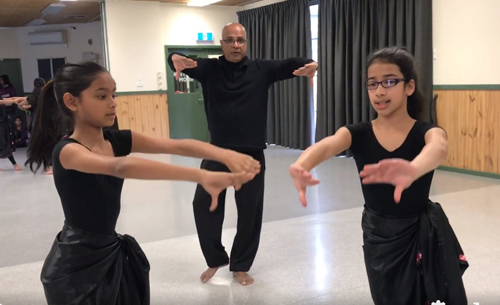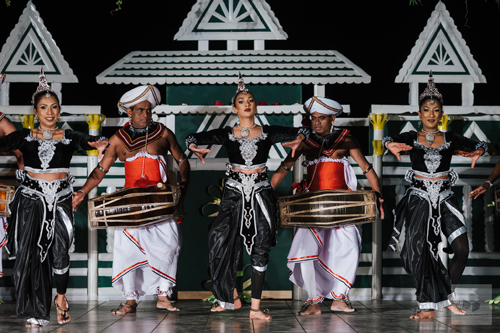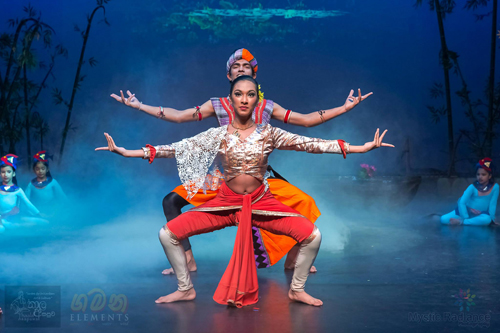Moving to the rhythms of Sri Lanka in Melbourne

Showing the way: Chalanka trains young dance enthusiasts at his academy
The powerful beats of a davula reverberate across the studio in Berrick, as a group of young men and women practise the subtle variations in line, movement and hand gestures between the dance forms of the Matara, Raigama and Benthara regions of southern Sri Lanka. It is the open day of Thaala Asapuwa, an opportunity for the Melbourne public to discover traditional Sinhala dance forms.
Twenty young people have attended to explore possibilities of learning dance. Current students are practising their steps. There are four sessions of workshops: drumming, Kandyan dance, low country dance and creative choreography. Watching them is Chalanka Athalage, a man with a mission. When not in his corporate persona as a Personal Financial Consultant, this is where he is: at Thaala Asapuwa Sri Lanka Academy of Dance in Melbourne, coaching children and adults to move to the rhythms of ancient Sri Lanka.
For his students, the open day is an opportunity to refine their skills under visiting master teacher from Sri Lanka, Prasanna Rupathilleke. Practice will perfect their roles in Saman Giri Varuna, the upcoming public performance of this academy of traditional Sinhala dance that Chalanka founded in 2009. Almost all the students are second generation Australians, for whom Sri Lanka is a distant place. Yet here they are, embodying the very soul of their ancestral roots in movement and sound.

Sanukshi Athalage (centre) flanked by Dulanee Liyanaarachchi ( left) and Asika Pelenda (right) with Prasanna Rupathilleke seen between Sanukshi and Dulanee. Pix courtesy Thaala Asapuwa
Saman Giri Varuna, or Poems of the Golden Butterflies, is Chalanka’s creation; a mudra natya, Sinhala ballet. It is an ambitious production, sequencing numerous mythical, historical, and cultural stories of Sri Lanka, retold by the golden butterflies who migrate to Siri Pada each year. The story’s timeline spans the ancient past with King Ravana paying homage to the sun at Siri Pada; the Buddha’s visit to the peak upon the invitation of God Saman after he brought peace to the warring nagas and the yakkas; Kuveni’s betrayal by Prince Vijaya; events linking the peak to kings Dutugemunu, Nissankamalla, Parakramabahu, and Seethavaka Rajasinghe; and an aluth sahal mangalaya at the Maduwanwala walawwa in Ratnapura two centuries ago, culminating in a pilgrimage to Saman Giri and a sun salutation.
Taking on multiple roles in this layered performance, the students absorb the diversity of Sinhala dance into their personal repertoire of movements. They learn it all, from vannams to Ves of Kandyan dance, low country and, from this year, Sabaragamuwa dance forms. The latter had not been offered at the school thus far, but the nature of Saman Giri Varuna, set in the Sabaragamuwa province, has called for the genre. Chalanka’s daughter Sanushki, Thaala Asapuwa’s principal dancer, choreographer and dance teacher, learned Sabaragamuwa dance in Sri Lanka last year to teach it to students.
Not present on the open day were the tots aged four and above, his youngest students, also in the performance. With weekly dance classes, and preparations spanning over two years, they too have become expert in their roles. When the performance culminated a week later at Bunjil Place in Narre Warren, Melbourne, they captivated audiences with perfect timing and precise movements, as this writer discovered watching them perform.
Importantly for Chalanka, the little ones are a new generation imbued with the dance culture so close to his heart. Chalanka loved dance and learned Kandyan dance aged 17 under many gurus, the two principal being Nandana Baalasuriya, as a student at D.S. Senanayake College, and then Tikiri Banda Adhikari from Kurunegala. Age 22 marked the beginning of a hiatus when he focussed on the corporate world. He re-embraced dance when he migrated to New Zealand 12 years later, joining the Sri Lankan Dance Academy of Wellington founded by Dayani Gonsalkorale.
On the school’s website, Dayani says Chalanka’s vast dance experience took her school’s performances to a higher level. In his 11 years with them, the school put on three public performances drawing on Sri Lanka’s rich mythology, folklore and culture.
 Four years after he founded Thaala Asapuwa, Chalanka produced his first Australian production, Dumbara Asiriya extolling the virtues and beauty of the Dumbara Valley village. “Dumbara is many things; a centre of folk culture, dance and everything. It has a very ancient history. The pel kavi of the farming community who live there are collectively called Dumbara asiriya,” Chalanka said.
Four years after he founded Thaala Asapuwa, Chalanka produced his first Australian production, Dumbara Asiriya extolling the virtues and beauty of the Dumbara Valley village. “Dumbara is many things; a centre of folk culture, dance and everything. It has a very ancient history. The pel kavi of the farming community who live there are collectively called Dumbara asiriya,” Chalanka said.
Thereafter, the school has presented regular concerts. Gamana, a journey through the five elements – earth, water, fire, wind, and air – followed, then Haram Paaliya, a journey through rhythm, and Kadawara Yaagaya, his first mudra natya or Sinhala folk ballet about a mysterious forest dweller named Kadawara who influenced the building of the Kalawewa and gave up his life for it. Sri Lanka, steeped in myth, lore and history, provides ample sustenance for these creations. Saman Giri Varuna is the latest, after an interval for Covid during which he continued classes online via Zoom.
Though not strictly purist in their approach to dance, Thaala Asapuwa is firmly based on traditional Sinhala dance forms. Dance forms such as Bollywood or ballroom have no place with them. “We become creative, but within the framework of traditional dance. We are a traditional dance school… My view is that there is a niche for traditional dance to continue. Public performances are confined to stage presentations, and we do not perform at social events such as weddings.”
Thaala Asapuwa started off with 11 students and now has 30, the majority being female. Chalanka says male students tend to drop out in their teens. Students receive a thorough immersion in the traditional dance arts. Exposure to teachers from Sri Lanka such as Prasanna Ru and his Dance Ensemble of five, with whom the school has a long relationship, reinforce this bonding as they meet via Zoom or face to face. The dance productions also include collaboration with other Sri Lanka-based artistes such as actor Ashan Dias and music composer Pabulu Wijegoonewardena.
The elaborate storylines of his ballets impart valuable lessons in Sri Lanka’s history, society, and culture to students in addition to building character and confidence. “Our parents teach us the history of Sri Lanka, but what better way to learn it than to live it through dance,” says Sanushki.
Sanushki choreographed Saman Giri Varuna, assisted by Asika Pelenda, who has been with Thaala Apasuwa since 2015, after being captivated while watching Gamana. Both Shanushki and she are also proficient in the classical South Indian dance form, Bharatanatyam. A dentist by profession, Asika studied under renowned Sri Lankan Australian dancer Niruththa Tharmakulendran for 25 years. To enhance storytelling, they incorporated facial expressions and hand gestures into some segments of Saman Giri Varuna. “We find creative and respectful ways to push boundaries without deviating from the artform,” she said.
Traditional Sri Lankan dance is alive around the world. Kandyan dance in particular is flourishing globally with the flow of the Sri Lankan diaspora. A Google search even reveals a Kandyan dance school in the U.A.E. Extraordinarily, the genre has taken root in Chile. Two Chilean Kandyan dancers participated in Saman Giri Varuna. Maria Paz Vallejos learned Kandyan dance from a Dutch dancer Mentjie Orsel, a student of the Chitrasena School of Dance, who started a school of Kandyan dance in Santiago. A political science graduate, Maria was drawn to online videos of Chalanka’s dance classes because of the depth of dance and culture they contained. She joined his Zoom classes during the Covid lockdown and flew down to participate in the performance. Kandyan dance has a special following in Chile, she says, recalling her surprise at seeing Chilean pupils at a school in Talinay, Chile, perform Kandyan dance routines. She runs her own school in Chile, with classes in Santiago and Valparaiso in Chile.
Thaala Asapuwa is not the only school of traditional Sinhalese dance in Melbourne but, it is the only school in Victoria to have a state-sponsored performance. A second performance Kadawara Yagaya received government sponsorship allowing more people to witness the immense effort poured into its production. Chalanka hopes to have a second performance of Saman Giri Varuna this year.
In 2019, Thaala Asapuwa saw the graduation of seven dancers in an elaborate kohomba kankariya ceremony performed at a Buddhist temple. Three of them, one a medical doctor, now teach at the academy. Chalanka is looking forward to the second graduation next year. Attendance, whether to teach or learn, requires some sacrifice, but since most of the academy are present for the love of dance, they don’t mind making the sacrifice, Chalanka says. It’s about the preservation of heritage and enduring legacies of
Sri Lankan traditions in a world marked by rapid change.
Searching for an ideal partner? Find your soul mate on Hitad.lk, Sri Lanka's favourite marriage proposals page. With Hitad.lk matrimonial advertisements you have access to thousands of ads from potential suitors who are looking for someone just like you.


